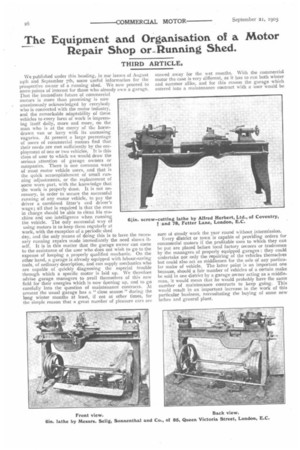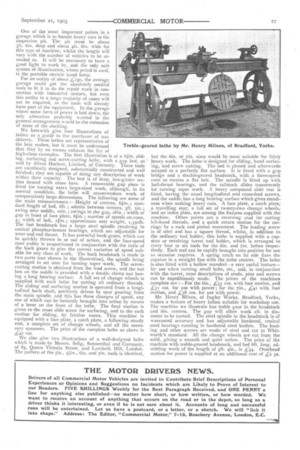The Equipment and Organisation of a Motor Repair Shop or-Running Shed.
Page 10

Page 11

If you've noticed an error in this article please click here to report it so we can fix it.
THIRD ARTICLE,
We published under this heading, in our issues of August 24th and September 7th, some useful information for the prospective owner of a running shed. We now proceed to some points of interest for those who already own a garage. That the immediate future of commercial motors is more than promising is now unanimously acknowledged by everybody who is connected with the motor industry, and the remarkable adaptability of these vehicles to every form of work is impressing itself daily, more and more, on the man who is at the mercy of the horsedrawn van or lorry with its unceasing vagaries. At present a large percentage of users of commercial motors find that their needs are met sufficiently by the employment of one or two vehicles. It is this class of user to which we would draw the serious attention of garage owners or companies. There is one common want of most motor vehicle users, and that is the quick accomplishment of small running adjustments, or the replacement of some worn part, with the knowledge that the work is properly done. It is not necessary, in order to secure the successful running of any motor vehicle, to pay the driver a combined fitter's and driver's wage; all that is required is that the man in charge should be able to clean his machine and use intelligence when running the vehicle. The only successful way of using motors is to keep them regularly at work, with the exception of a periodic shed day, and the only means of doing this is to have the necessary running repairs made immediately the need shows itself. It is in this matter that the garage owner can come to the assistance of the user who does not wish to go to the expense of keeping a properly qualified mechanic. On the other hand, a garage is already equipped with labour-saving tools, of ordinary description, and can supply mechanics who are capable of quickly diagnosing the especial trouble through which a specific motor is laid up. We therefore advise garage managers to avail themselves of this new field for their energies which is now opening up, and to go carefully into the question of maintenance contracts. At present the usual garage has a " close season " during the long winter months at least, if not at other times, for the simple reason that a great number of pleasure cars are
8iin.
stowed away for the wet months. With the commercial motor the case is very different, as it has to run both winter and summer alike, and for this reason the garage which entered into a maintenance contract with a user would be
sure of steady work the year round without intermission.
Every district or town is capable of providing orders for conunercial motors if the profitable uses to which they can be put are placed before local factory owners or tradesmen by the managers of properly equipped garages : they could undertake not only the repairing of the vehicles themselves but could also act as middlemen for the sale of any particular make of vehicle. The latter point is an important one because, should a fair number of vehicles of a certain make be sold in one district by a garage owner acting as a middleman, it would mean that he would probably have the same number of maintenance contracts to keep going. This would result in an important increase in the work of this particular business, necessitating the buying of some new lathes and general plant.
One of the most important points in a garage which is to handle heavy cars is the inspection pit. The pit must be about 3ft. bin. deep and about 4ft. 6in. wide for this type of machine, whilst the length will
vary with the number of vehicles to be attended to. It will be necessary to have a good light to work by and the only safe system of illumination, where petrol is used, is the portable electric hand lamp. For an outlay of about .4;150, the average garage could get the absolutely needful
tools to fit it to do the repair work in"con nection with industrial motors, but even this outlay in a large majority of cases will not be required, as the tools will already
form part of the equipment. In the garage where some form of power is laid down, the only alteration probably w a nred in the general arrangement would be the extension of some of the shafting.
We herewith give four illustrations of lathes as a guide to 'the purchaser of ma
chinery. These lathes are representative of the best makes, but it must be understood that they by no means exhaust the list of high-class examples. The first illustration is of a 6in. sliding, surfacing and screw-cutting lathe, with a gap bed, as sold by Alfred Herbert, Limited, of Coventry. These tools are excellently designed, substantially constructed and well finished; they are capable of doing any description of work within their capacity. The bed is of deep, box-girder section braced with cross bars. A removeable gap piece is fitted for turning extra large-sized work, although, in its normal condition, the lathe will accommodate work of comparatively large dimensions. The following are some of the main measurements :—Height of centres, 6in.; standard length of bed, 6ft.; admits between centres, 3ft. 3in.; swing over saddle, Join.; swings in the gap, 261n.; width of gap in front of face plate, 8iin. ; number of speeds on.cone, 4; width of belt, Iin. ; approximate nett weight, 1,3501b. The fast headstock has a large steel spindle revolving in conical phosphor-bronze bearings, which are adjustable for wear and end thrust. It has powerful back gears, which can be quickly thrown in or out of action, and the four-speed cone pulley is proportioned in conjunction with the ratio of the back gears to give the correct variation of speed suitable for any class of work. The back headstock is made in two parts (not shown in the illustration), the spindle being arranged to set over for turning taper work. The screwcutting motion is obtained from the lead screw, and the nut box on the saddle is provided with a double clamp nut having a long bearing surface. A full set of change wheels is supplied with each lathe for cutting all ordinary threads. The sliding and surfacing motion is operated from a longitudinal back shaft, positively driven by spur gearing from the main spindle, and this has three changes of speed, any one of which can be instantly brought into action by means of a lever on the front of the lathe. The final motion is given to the cross slide screw for surfacing, and to the rack motion for sliding, by friction cones. This machine is equipped with a face plate, a catch plate, a following steady rest, a complete set of change wheels, and all the necessary spanners. The price of the complete lathe as above is £42 10S.
We also give two illustrations of a well-designed lathe which is made by Messrs. Selig, Sonnenthal and Company, of 85, Queen Victoria Street, and Lambeth I-1111, London. The pattern of the sin., 5;in., Gin. arid yin, tools is identical,
but the 6in. or yin. sizes would be most suitable for fairly heavy work. The lathe is designed for sliding, hand surfacing, and screw cutting. The bed is planed and afterwards scraped to a perfectly flat surface. It is fitted with a gap bridge and a double-geared headstock, with a three-speed cone to receive a flat belt. The spindle is fitted up with ball-thrust bearings, and the tailstock slides transversely for turning taper work. A heavy compound slide rest is fitted, having the usual longitudinal and cross-feed screws, and the saddle has a long bearing surface which gives steadiness when making heavy cuts. A face plate, a catch plate; a travelling stay, a full set of twenty-two change wheels, -and an index plate, are among the fixtures supplied with the machine. Other points are a reversing stud for cutting left-hand threads, and a quick return motion for the carriage by a rack and pinion movement. The leading screw is of steel and has a square thread, whilst, in addition to the ordinary tool, holder, this lathe is supplied with a capstan or revolving turret tool holder, which is arranged to carry four or six tools for the 6in. and yin. lathes respectively. Each tool can be rapidly brought into position for use as occasion requires. A spring catch on its side fixes the capstan in a straight line with the lathe centres. The lathe is also fitted with a hollow mandrel—a very useful featurefo:use when turning small bolts, etc., and, in conjunction with the turret, most descriptions of studs, pins and screws can be expeditiously made. The prices of the machines
complete are :—For the 6in., Ins, with foot motion, and £31 los. for use with power ; for the 7in., £41 with foot motion, and £38 ios. for use with power.
Mr. henry Milnes, of Ingley Works, Bradford, Yorks, makes a feature of heavy lathes suitable for workshop use. The machine we illustrate has treble gear in the headstock and 6in. centres. The gap will allow work aft, in diameter to be turned. The steel spindle in the headstock is of warranted accuracy and has adjustable hardened, conical steel bearings running in hardened steel bushes. The leading and other screws are made of steel and cut to Whitworth's standard. All the change wheels are cut from the solid, giving a smooth and quiet action. The price of the machine with treble-geared headstock, and bed 8ft. long, admitting work of the length of 5ft. kin., is .4;54. Overhead motion for power is supplied at an additional cost of ,Z.2 5s.
















